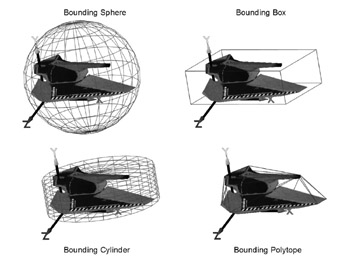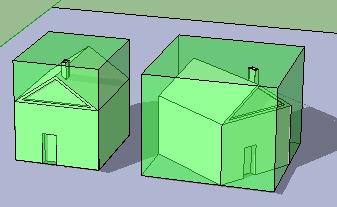Lecture 09: Acceleration structures
Computer graphics in Game development

Ivan Belyavtsev
10.06.2022
Raytracing complexity
In the case of 1 ray per pixel without additional ray casting the complexity of ray tracing is rays number * (triangles number * MT algorithm cost + Closest Hit cost)
[2]
Complexity reduction strategies
- Traversing bigger chunks of geometry at the same time
- Reducing the cost of the MT algorithm
- Using non-linear data structures
Model grouping
Obj file was parsed to a vector of shapes. Each shape has its own vertex and index buffers. Let’s use the each shape as a single chunk for traversing. How we can find the shape-ray intersection?
Bounding volume

Axis-aligned bounding boxes (AABB)

AABB intersection algorithm
float3 invRaydir = float3(1.0) / ray.direction;
float3 t0 = (aabb_max - ray.position) * invRaydir;
float3 t1 = (aabb_min - ray.position) * invRaydir;
float3 tmin = min(t0, t1);
float3 tmax = max(t0, t1);
return maxelem(tmin) <= minelem(tmax);[3]
Bounding volume hierarchy
- Top-level acceleration structures (TLAS)
- Bottom-level acceleration structures (BLAS)
How to build trees of acceleration structures
Surface area heuristic (SAH):
\[C(A, B) = t_{trav}+p_{A}\sum_{i=1}^{N_A}t_{int}(a_i) + p_{B}\sum_{i=1}^{N_B}t_{int}(b_i)\]
where \(C\) - cost of traversing the node, \(p_{A}\) and \(p_{B}\) are the probabilities that the ray passes through the subvolumes \(A\) and \(B\) [4]
Question: why TLAS won’t speed up the Cornell box scene?

Lab: 2.05 Axis-aligned bounding boxes
- Implement
aabbclass - Implement
build_acceleration_structuremethod ofraytracerclass - Adjust
trace_raymethod ofraytracerclass to traverse the acceleration structure - Adjust
ray_tracing_rendererclass to build the acceleration structure
References
1.
Lefrançois M.-K., Gautron P. DX12 raytracing
tutorial - part 2 [Electronic resource]. URL: https://developer.nvidia.com/rtx/raytracing/dxr/DX12-Raytracing-tutorial-Part-2.
2.
Parker S.G. et al. OptiX: A general purpose
ray tracing engine // ACM SIGGRAPH 2010 papers. New York, NY, USA:
Association for Computing Machinery, 2010.
3.
McGuire M. The graphics codex. 2.14 ed. Casual
Effects, 2018.
4.
Pharr M., Jakob W., Humphreys G. Physically
based rendering: From theory to implementation [Electronic resource].
2021. URL: https://pbr-book.org/.